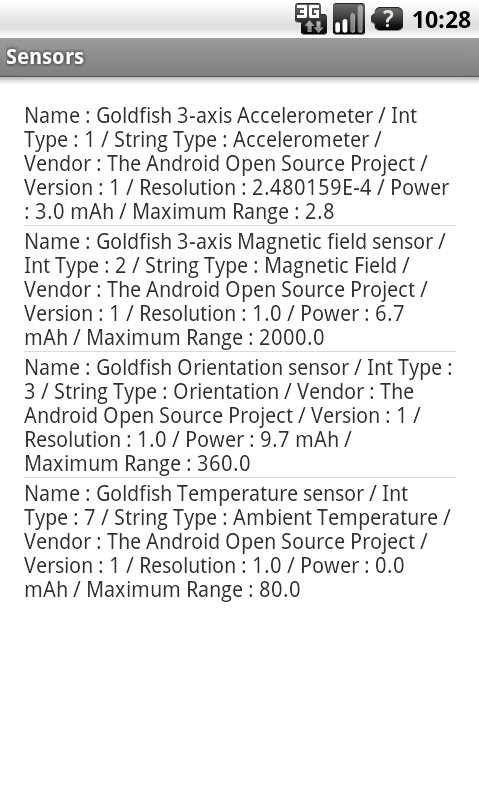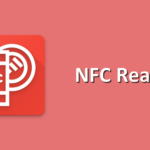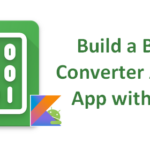List all sensors available on an Android device
Android devices have a lot of sensors inside. Android SDK put on the hands of developers all the necessary APIs to take advantages of them and offer to their users applications that use them. In this tutorial, you’re going to learn how to list all the sensors available on an Android device. In a future tutorial, we will see how to monitor their activity.
1/ List all sensors available
First, we need to list all sensors available. We need to get instance of SensorManager service then call the getSensorList method by entering Sensor.TYPE_ALL parameter like that :
1 2 | SensorManager sensorManager = (SensorManager) getSystemService(Context.SENSOR_SERVICE);List<Sensor> sensors sensors = sensorManager.getSensorList(Sensor.TYPE_ALL); |
Here, sensors list contains all the sensors available on the Android device.
2/ Display all the sensors on a list
To display all the sensors, we need to create a simple layout with a ListView :
01 02 03 04 05 06 07 08 09 10 11 12 13 14 15 16 17 | android:layout_width="match_parent" android:layout_height="match_parent" android:paddingBottom="@dimen/activity_vertical_margin" android:paddingLeft="@dimen/activity_horizontal_margin" android:paddingRight="@dimen/activity_horizontal_margin" android:paddingTop="@dimen/activity_vertical_margin" tools:context=".MainActivity" > <ListView android:id="@+id/list" android:layout_width="fill_parent" android:layout_height="wrap_content" /></RelativeLayout> |
We must define also the layout for items :
01 02 03 04 05 06 07 08 09 10 11 12 | <?xml version="1.0" encoding="utf-8"?> android:layout_width="match_parent" android:layout_height="match_parent" android:orientation="vertical" > <TextView android:id="@+id/content" android:layout_width="wrap_content" android:layout_height="wrap_content" /></LinearLayout> |
Then, we define an adapter implementation :
01 02 03 04 05 06 07 08 09 10 11 12 13 14 15 16 17 18 19 20 21 22 23 24 25 26 27 28 29 30 31 32 33 34 35 36 37 38 39 40 41 42 43 | protected static class MySensorsAdapter extends ArrayAdapter<Sensor> { private int textViewResourceId; private static class ViewHolder { private TextView itemView; } public MySensorsAdapter(Context context, int textViewResourceId, List<Sensor> items) { super(context, textViewResourceId, items); this.textViewResourceId = textViewResourceId; } public View getView(int position, View convertView, ViewGroup parent) { ViewHolder viewHolder = null; if (convertView == null) { convertView = LayoutInflater.from(this.getContext()).inflate(textViewResourceId, parent, false); viewHolder = new ViewHolder(); viewHolder.itemView = (TextView) convertView.findViewById(R.id.content); convertView.setTag(viewHolder); } else { viewHolder = (ViewHolder) convertView.getTag(); } Sensor item = getItem(position); if (item != null) { viewHolder.itemView.setText("Name : " + item.getName() + " / Int Type : " + item.getType() + " / String Type : " + sensorTypeToString(item.getType()) + " / Vendor : " + item.getVendor() + " / Version : " + item.getVersion() + " / Resolution : " + item.getResolution() + " / Power : " + item.getPower() + " mAh" + " / Maximum Range : " + item.getMaximumRange()); } return convertView; }} |
Note that we use ViewHolder pattern. You can also see that we need a method to get sensor type name from sensor type integer value. This static method is called sensorTypeToString :
01 02 03 04 05 06 07 08 09 10 11 12 13 14 15 16 17 18 19 20 21 22 23 24 25 26 27 28 29 30 31 32 33 34 35 36 37 38 39 40 41 42 43 44 45 46 | public static String sensorTypeToString(int sensorType) { switch (sensorType) { case Sensor.TYPE_ACCELEROMETER: return "Accelerometer"; case Sensor.TYPE_AMBIENT_TEMPERATURE: case Sensor.TYPE_TEMPERATURE: return "Ambient Temperature"; case Sensor.TYPE_GAME_ROTATION_VECTOR: return "Game Rotation Vector"; case Sensor.TYPE_GEOMAGNETIC_ROTATION_VECTOR: return "Geomagnetic Rotation Vector"; case Sensor.TYPE_GRAVITY: return "Gravity"; case Sensor.TYPE_GYROSCOPE: return "Gyroscope"; case Sensor.TYPE_GYROSCOPE_UNCALIBRATED: return "Gyroscope Uncalibrated"; case Sensor.TYPE_HEART_RATE: return "Heart Rate Monitor"; case Sensor.TYPE_LIGHT: return "Light"; case Sensor.TYPE_LINEAR_ACCELERATION: return "Linear Acceleration"; case Sensor.TYPE_MAGNETIC_FIELD: return "Magnetic Field"; case Sensor.TYPE_MAGNETIC_FIELD_UNCALIBRATED: return "Magnetic Field Uncalibrated"; case Sensor.TYPE_ORIENTATION: return "Orientation"; case Sensor.TYPE_PRESSURE: return "Orientation"; case Sensor.TYPE_PROXIMITY: return "Proximity"; case Sensor.TYPE_RELATIVE_HUMIDITY: return "Relative Humidity"; case Sensor.TYPE_ROTATION_VECTOR: return "Rotation Vector"; case Sensor.TYPE_SIGNIFICANT_MOTION: return "Significant Motion"; case Sensor.TYPE_STEP_COUNTER: return "Step Counter"; case Sensor.TYPE_STEP_DETECTOR: return "Step Detector"; default: return "Unknown";} |
3/ Run the sensors list application
Before to run the sensors list application, we just need to add the following line to set the adapter to the listview instance in the onCreate method on an Activity for example :
1 | list.setAdapter(new MySensorsAdapter(this, R.layout.row_item, sensors)); |
The demo gives the following result :
In a future tutorial, we will see how to monitor sensors activity by register to listen their events.




Leave a Reply
You must be logged in to post a comment.